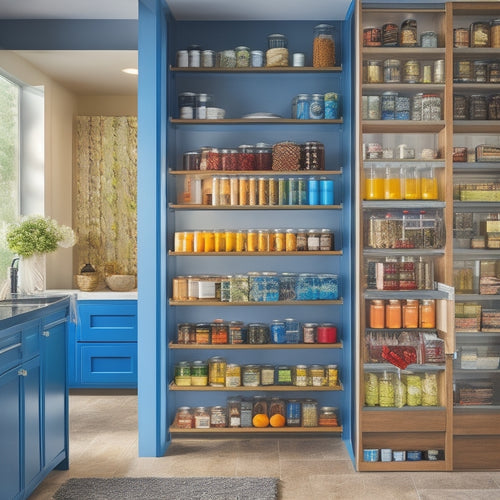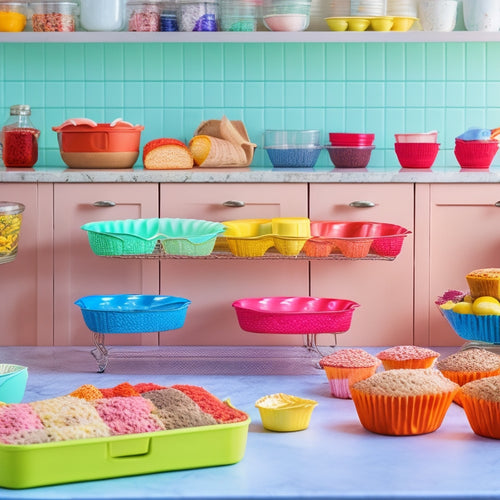
Kitchen Mastery Guide: Ideal Storage & Prep
Share
Effectively storing and preparing ingredients is essential for achieving kitchen mastery. Ideal storage methods, such as organizing dry goods and wrapping fish tightly, maintain food quality and prevent spoilage. Proper marinating, seasoning, and handling of meat, fish, and produce ensure food safety and enhance flavor. Efficient meal preparation relies on fundamental skills like knife work, seasoning, and cooking methods. A well-organized kitchen, with designated areas for prep, cooking, and cleanup, streamlines the cooking process and fosters creativity. By optimizing storage and prep techniques, home cooks can maximize the full potential of their ingredients and elevate their culinary creations.
Key Takeaways
• Accurate weight conversions and cooking times ensure tender, flavorful, and safe meat preparation.
• Ideal storage conditions, such as temperature and humidity, prolong the shelf life of fresh produce.
• Handle fish fillets gently, pat dry, and store at 0°F (-18°C) or below to preserve quality.
• Developing fundamental food preparation techniques, like knife skills and seasoning, elevates dish quality and ensures food safety.
• Categorize and store dry goods in airtight containers, and plan meals in advance to optimize kitchen resources and efficiency.
Mastering Meat Preparation Basics
Accurate weight conversions and cooking times are important in meat preparation, as they directly impact the tenderness, flavor, and food safety of the final dish.
A thorough understanding of meat marinating and seasoning techniques is also crucial to achieve best results. Meat marinating involves soaking the meat in a mixture of seasonings, acids, and oils to enhance flavor and tenderize the meat.
Meat seasoning, on the other hand, involves applying a blend of spices and herbs to the meat's surface to add flavor.
When marinating and seasoning, it's crucial to follow safe food handling practices to prevent cross-contamination and foodborne illness.
Fresh Produce Storage Essentials
As home cooks master the art of meat preparation, they must also consider the importance of properly storing fresh produce to maintain its flavor, texture, and nutritional value. Fresh produce storage essentials involve understanding ideal storage and handling techniques to prolong shelf life and prevent spoilage.
Fruit ripening and vegetable preservation require specific conditions, such as temperature, humidity, and light exposure, to slow down metabolic processes. For instance, leafy greens and herbs require high humidity and cool temperatures, while tropical fruits like mangos and papayas thrive in warmer conditions.
Fish Storage and Handling Tips
Properly storing fish is vital to maintaining its quality, food safety, and nutritional value, as incorrect storage can lead to spoilage, contamination, and even foodborne illness. When handling fish, it's important to prioritize cleanliness and hygiene to prevent cross-contamination.
Here are some key tips to keep in mind:
-
Handle fish fillets gently to prevent damage and bruising, and pat them dry with paper towels before storing to remove excess moisture.
-
Freeze fish at 0°F (-18°C) or below to preserve its quality and prevent freezer burn. When freezing fish, it's best to wrap it tightly in plastic wrap or aluminum foil to prevent freezer burn.
-
Always label and date stored fish to make certain you use the oldest items first and can track its storage duration.
Essential Food Preparation Techniques
Beyond storing and handling fish, mastering essential food preparation techniques is important to unlocking the full flavor and nutritional potential of ingredients. Two fundamental skills every home cook should possess are knife skills and seasoning techniques. Developing these skills can elevate the quality of dishes and ensure food safety.
| Technique | Description |
|---|---|
| Knife Skills | Properly chopping, slicing, and dicing ingredients to guarantee uniform cooking and presentation |
| Seasoning Techniques | Balancing flavors through salt, acid, and aromatics to enhance the natural taste of ingredients |
| Cooking Methods | Understanding various cooking methods, such as roasting, grilling, and sautéing, to achieve best results |
| Meal Preparation | Efficiently planning and preparing meals to reduce food waste and save time |
Advanced Kitchen Organization Strategies
Optimizing kitchen workflow relies heavily on implementing advanced organization strategies that streamline food preparation, reduce clutter, and enhance overall cooking efficiency. By implementing these strategies, home cooks can create a safe and functional kitchen environment that fosters creativity and productivity.
Some essential advanced organization strategies include:
-
Pantry organization: categorize and store dry goods in airtight containers to maintain freshness and visibility
-
Meal planning: plan and prep meals in advance to reduce food waste and optimize kitchen resources
-
Station setup: designate specific areas for food prep, cooking, and cleanup to promote workflow efficiency and reduce cross-contamination
Frequently Asked Questions
How Do I Prevent Moisture Buildup in My Kitchen Cabinets?
To prevent moisture buildup in kitchen cabinets, consider a dehumidifier solution to absorb excess moisture, and guarantee proper cabinet ventilation by installing vents or fans to facilitate airflow and reduce humidity.
What Is the Ideal Temperature for a Kitchen Refrigerator?
'An ounce of prevention is worth a pound of cure.' The perfect temperature for a kitchen refrigerator is between 37°F and 40°F (3°C and 4°C), ensuring excellent refrigerator maintenance and food storage, thereby preventing spoilage and promoting food safety.
Can I Use Aluminum Foil to Store Food in the Freezer?
When storing food in the freezer, it's generally safe to use aluminum foil for wrapping, but provide airtight sealing to prevent freezer burn and maintain best freezer organization for effective food preservation.
How Often Should I Clean My Kitchen Trash Cans?
'Coincidentally, a clean kitchen trash can is essential in maintaining a hygienic environment. To prevent odor buildup, replace liners every 1-2 weeks and deep clean cans monthly with soap and warm water, ensuring a safe and sanitary space.'
What Is the Best Way to Organize Spices in a Small Kitchen?
Optimize spice storage in small kitchens by utilizing a wall-mounted spice rack with labeling or a drawer organizer with dividers, ensuring easy access and visibility while maintaining a clutter-free environment that promotes food safety.
Related Posts
-

Sliding Pantry Organizers With Tiered Racks
Sliding pantry organizers with tiered racks optimize your pantry space and enhance accessibility. These organizers cr...
-

Roll-Out Trays for Organizing Baking Supplies
Roll-out trays are perfect for organizing your baking supplies, making your kitchen more efficient. They maximize spa...
-

Under-Sink Storage Bins for Organized Kitchens
Under-sink storage bins are your best bet for an organized kitchen. They maximize unused cabinet space and enhance it...


